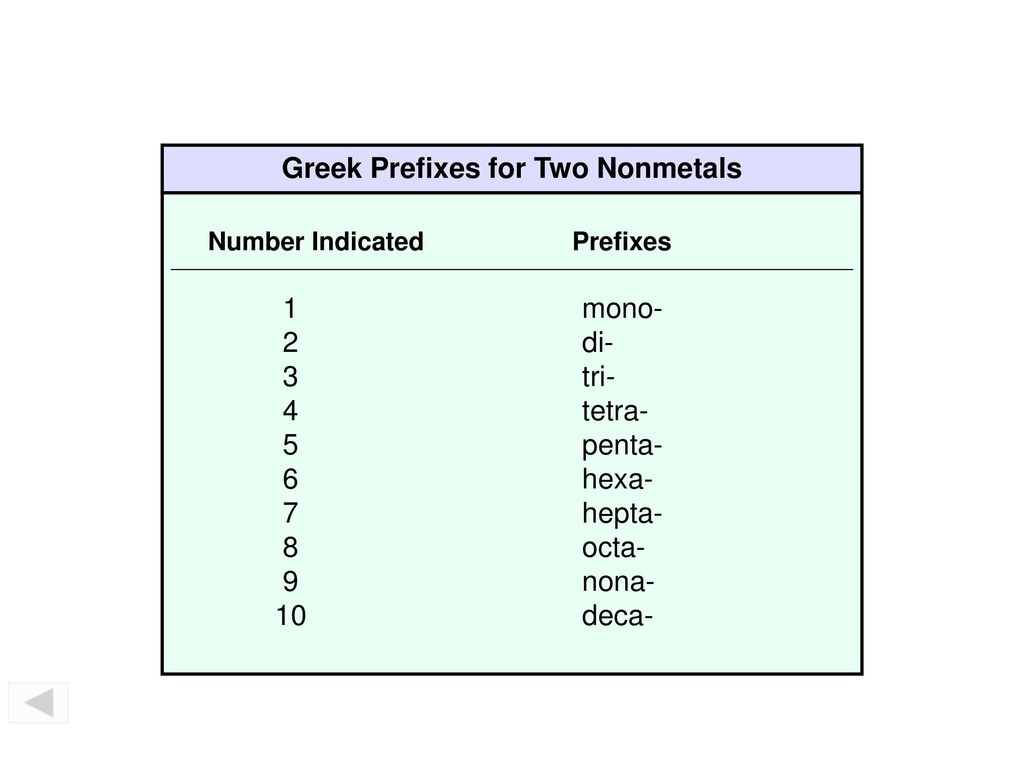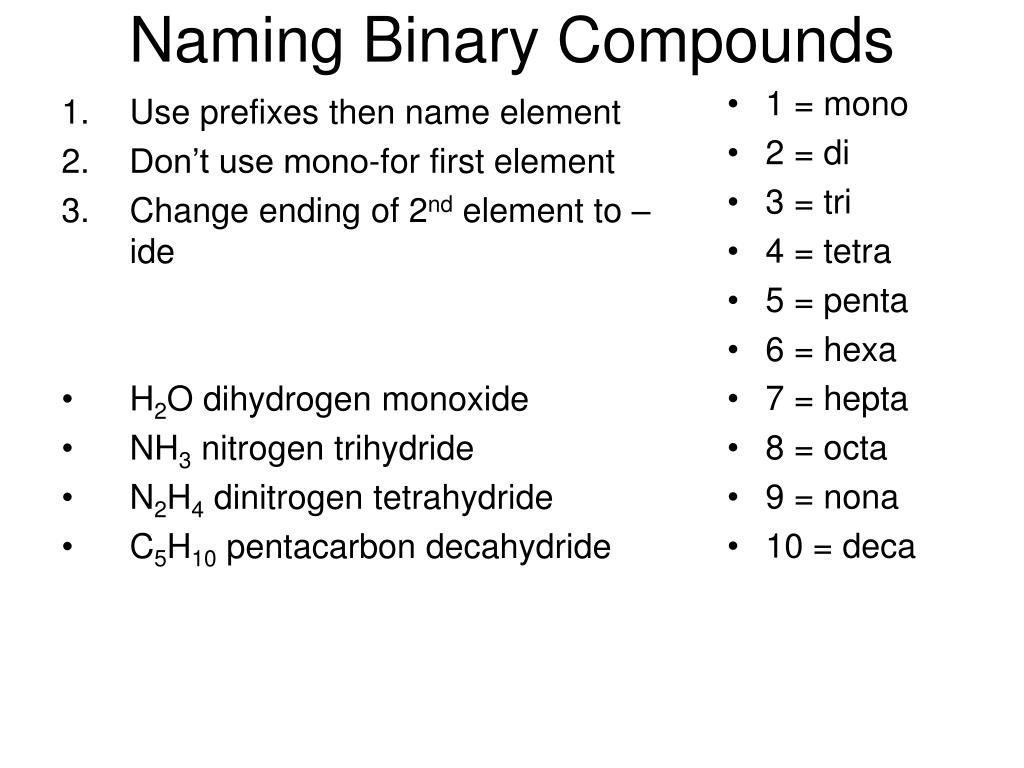Ionic compounds - AQA. Suppose that you want to name the compound that results from the reaction of lithium and sulfur.
 How To Name Ternary Ionic Compounds
How To Name Ternary Ionic Compounds
The second part is the name of the nonmetal element with the suffix -ide.

How to name ionic compounds. In this tutorial we will be learning how to name ions and ionic compounds from the formula and how to find the formula from the compound name. The cation has the same name as its element. Jot down the formula of the ionic compound.
An ionic compound is named first by its cation and then by its anion. When an ion consists of more than one element we refer to it as a polyatomic ion To recognize an ionic compound look for the presence of a metal or a known polyatomic ion - once you find one you more than likely have an ionic compound. An ionic compound is made up of charged particles called ions.
Naming Ionic Compounds Using -ous and -ic. When you name binary ionic compounds with transition metals the rules are the same as those of binary ionic compounds. The cation has the same name as its element.
It has a giant lattice structure with strong electrostatic forces of attraction. Ions of either variety may contain either a single element or more than one element. Left of the metalloid staircase it is a metal and the compound is ionic When naming ionic compounds we never indicate the ratio of component elements in the name - that is for covalent compounds only.
If the first element you see in the compound is found on the left side of the periodic table ie. The names for transition metal compounds often have roman numerals in them beca. Some examples of names for ionic compounds.
Consult the periodic table of elements. The first part of the name is the name of the metal element. You first write the name of the metal lithium and then write the name of the nonmetal adding an -ide ending so that sulfur becomes sulfide.
The Roman numeral naming convention has wider appeal because many ions have more than two valences. Well learn how to name ionic compounds that have transition metals in them. Ionic and molecular compounds are named using somewhat-different methods.
For a two element ionic compound the naming is simple. The anion is named by taking the elemental name removing the ending and adding -ide. NaCl Sodium Chloride.
The ionic lattice An ionic compound is a giant structure of ions. These endings are added to the Latin name of the element eg stannousstannic for tin to represent the ions with lesser or greater charge respectively. Lets say the ionic compound youre working with is NaCl.
When you name ionic compounds you write the name of the metal first and then the nonmetal. Naming Basic Ionic Compounds. Use a pen or.
The ions have a regular repeating arrangement called an ionic lattice. When naming ionic compounds all of the information youll need is on the periodic table. The anion is named by taking the elemental name removing the ending and adding ide.
Although Roman numerals are used to denote the ionic charge of cations it is still common to see and use the endings -ous or -ic. This lesson will demonstrate how to write a chemical formula for a binary ionic compound when given the systemic name. With my strategy and step by step examples you will be naming compounds like a pro in no time.
It has a giant lattice structure with strong electrostatic forces of attraction. Google Classroom Facebook Twitter. Ionic compounds - AQA.
For example K 1 is called the potassium ion just as K is called the potassium atom. For example K 1 is called the potassium ion just as K is called the potassium atom. For binary ionic compounds ionic compounds that contain only two types of elements the compounds are named by writing the name of the cation first followed by the name of the anion.
An ionic compound is made up of charged particles called ions. The name of the metal is written first followed by the name of the nonmetal with its ending changed to ide. For example KCl an ionic compound that contains K and Cl- ions is named potassium chloride.
For example K 2 O is called potassium oxide. Naming compounds have never been so simple. Binary ionic compounds typically consist of a metal and a nonmetal.
An ionic compound is named first by its cation and then by its anion. The lattice is formed because the ions attract each other.
The following table lists the most common prefixes for binary covalent compounds. Greek prefixes see the Table provided at the bottom of this page are used to indicate the number of atoms of each nonmetal element in the chemical formula for the compound.
 Binary Molecular Compounds Ppt Download
Binary Molecular Compounds Ppt Download
Naming Type III Compoundsmp4.

Prefixes for binary compounds. Prefixes are used to denote the number of atoms. Common Prefixes for Binary Covalent Compounds. Covers molecular compound binary molecular compound molecules and naming of binary molecular compounds.
Naming Binary Covalent Compounds. Rules for naming binary compounds containing two nonmetals. Their names go back into the antiquity of chemistry and are considered common or trivial names rather than systematic names.
Refer to the explanation. Penta- 5 hexa- 6 hepta- 7 octa- 8 nona- 9 deca- 10. Binary covalent compoundsthat is covalent compounds that contain only two elementsare named using a procedure similar to that used to name simple ionic compounds but prefixes are added as needed to indicate the number of atoms of each kindThe procedure diagrammed in Figure 611 uses the following steps.
Each number has its own prefixList of Prefixesmono-di-tri-tetra-penta-hexa-hepta-octa-nona-deca. The rules for using the prefix system of nomenclature of binary compounds can be summarized as follows. The second element is named after the first but with the ending of the elements name changed to ide.
If the compound contains one atom of the element that is written first in the name the prefix mono- is not used. The prefix mono- is never used for naming the first element. Greek prefixes are used for binary two element molecular compounds.
Common Greek prefixes that are used to indicate the number of atoms of each element Indicate number of atoms of each element with Greek prefix before element name. When naming a binary molecular compound the subscript for each element determines what prefix should be used. A quick way to identify acids is to see if there is an H denoting hydrogen in front of the molecular formula of the compound.
To name acids the prefix hydro-is placed in front of the nonmetal modified to end with ic. Name each of the following compounds. The order of common nonmetals in binary compound formulas is C P N H S I Br Cl O F.
The first element is named first using the elements name. Prefixes 1-5 prefixes 6-10 Examples using prefixes 1 mono 2 di 3 tri 4 tetra 5 penta 6 hexa 7 hepta 8 octa 9 nona 10 deca CCl 4 carbon tetrachloride P 2 O 5 diphosphorus pentoxide. The computer industry has historically used the units kilobyte megabyte and gigabyte and the corresponding symbols KB MB and GB in at least two slightly different measurement systems.
A binary prefix is a unit prefix for multiples of units in data processing data transmission and digital information notably the bit and the byte to indicate multiplication by a power of 2. The number of atoms of each element is indicated with Greek prefixes. The state of acids is aqueous aq because acids are found in water.
The Greek prefixes are also used in naming binary compounds containing two nonmetals. Binary compounds containing two nonmetals. Video for Naming Type III Binary Compounds.
When naming the appropriate prefix is used only if there are more than one atom of that element in the formula. Simple acids known as binary acids have only one anion and one hydrogen. However it is virtually never called that.
Prefixes are used in the names of binary compounds to indicate the number of atoms of each nonmetal present. The following prefixes are used to specify the number of times an element is present in binary covalent compounds. Exercise 1 for Naming Type III Binary Compounds.
Mono 1 Hexa 6 Di 2 Hepta 7 Tri 3 Octa 8 Tetra 4 Nona 9 Penta 5 Deca 10 For example CO 2 is carbon dioxide while CO is carbon monoxide. Table 1 shows Greek prefixes used in naming some binary compounds and their meanings. Carbon is always first in a formula and hydrogen is after nitrogen in a formula such as ceNH_3.
Yes the name for water using the rules for chemical nomenclature is dihydrogen monoxide. Generally the less-electronegative element is written first in the formula though there are a few exceptions. Second element is named as an Anion suffix -ide 3.
Choose from 500 different sets of binary compounds prefixes used table flashcards on Quizlet. There is an extremely small number of binary gaseous compounds particularly binary compounds involving oxygen. These anions usually have the ending -ide As acids these compounds are named starting with the prefix hydro- then adding the first syllable of the anion then the suffix -ic For example HCl which is hydrogen and chlorine is called hydrochloric acid.
In the case of mono- it is only used for the second nonmetal. The second element has the ending -ide. For example as your correctly mention CO is commonly called carbon monoxide.
Name the first element by its name. Of atoms Greek Prefix of atoms Greek Prefix 1 mono usually omitted 6 hexa 2 di 7 hepta 3 tri 8 octa tetra 9 nona 5 ponta 10 deca. Binary molecular covalent compounds are named according to the number of atoms in the compound.
Some common binary acids include. Ionic compounds are named differently. When no prefix appears one atom.
Learn binary compounds prefixes used table with free interactive flashcards.